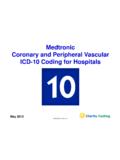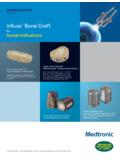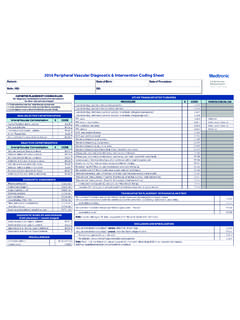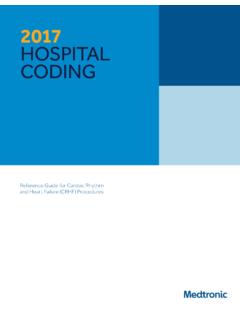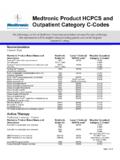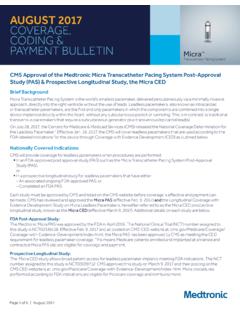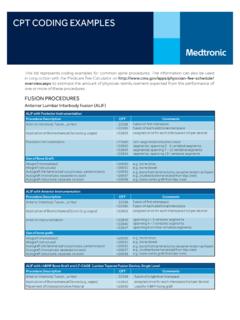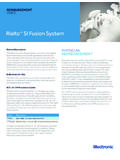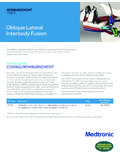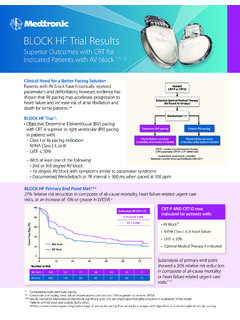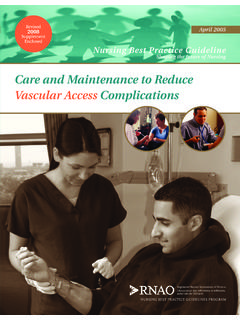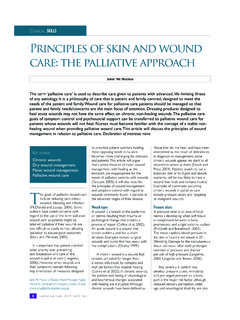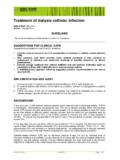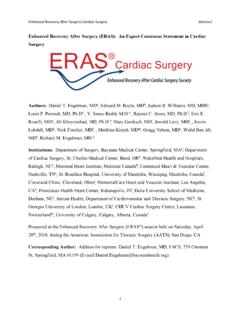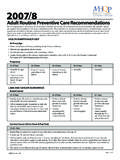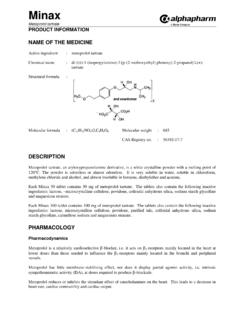Transcription of Sizing and application for optimal benefi t - Medtronic
1 Anti-Embolism Stockings Nursing Procedure GuideSizing and applicationfor optimal benefi Anti-Embolism Stockings anti-embolism stockings apply the clinically proven graduated pressure pattern of 18mmHg at the ankle, 14mmHg at the calf, 8mmHg at the popliteal, 10mmHg at the lower thigh and 8mmHg at the upper It is important to measure the patient s leg size to assure that the appropriate pressure pattern is applied. anti-embolism stockings are clinically proven to reduce the incidence of DVT up to 50%2 and to promote increased blood fl ow velocity in the legs 138%1 of baseline by compression of the deep venous system.
2 Anti-embolism stockings have been clinically proven to prevent the damaging effects of venous distension that occurs during surgery and Proven Pressure PatternUpper Thigh, 8mmHgLower Thigh, 10mmHgPopliteal, 8mmHgCalf, 14mmHgAnkle, 18mmHgULPCA Getting Started You will need: Wall Chart Tape Measure Stocking Order Pad/ Sizing Chart Package of Covidien anti-embolism stockings Nursing is responsible for Sizing , application , and maintenance of anti-embolism stockings. SizingProper Sizing and application must be assured for a patient to receive the optimal benefit of stockings.
3 Refer to instructions for use in packaging for specific Sizing information. A. Thigh Length and Thigh Length with Belt (Figure I)1. Measure upper thigh circumference at gluteal furrow. (Measurement #1)2. Measure calf circumference at greatest dimension. (Measurement #2)3. Measure leg length from gluteal furrow to base of heel. (Measurement #3)4. Consult the back of this guide, wall chart or product packaging to determine the appropriate size. a. If right and left legs measure differently, order two different stocking sizes.
4 B. If thigh circumference is greater than 36 inches, select a knee length stocking. c. If calf circumference is outside the specified range of the recommended thigh length stocking based on Measurement #1, select a knee length Knee Length (Figure II)1. Measure calf circumference at greatest dimension. (Measurement #1)2. Measure length from bend of knee to base of heel. (Measurement #2)3. Consult the wall chart or back of this guide to determine the appropriate size. a. If right and left legs measure differently, order two different stocking Order two pairs of stockings to ensure that prophylaxis is uninterrupted during laundering care or to send a pair home with the IIFig.
5 IDid you know?According to a study by Dr. Sigel, the effect of graduated compression stockings on venous velocity lasts up to 30 minutes after removal of the ApplyingA. Insert hand into stocking as far as the heel pocket (Figure III)Fig. IIIFig. VFig. IVFig. VIFig. VIIB. Grasp center of heel pocket and turn stocking inside out to heel area. (Figure IV)C. Position stocking over foot and heel. Be sure patient s heel is centered in heel pocket. (Figure V)D. Pull a few inches of the stocking up around the ankle and Continue pulling the stocking up the leg.
6 The stitch change (change in fabric sheerness) should fall between 1" to 2" below the bend of the knee. (Figure VI)F. As thigh portion of the stocking is applied, start rotating stocking inward so panel is centered over femoral artery. Panel is placed slightly towards the inside of the leg. When using thigh length, the top band rests in the gluteal furrow. (Figure VII)G. Smooth out wrinklesH. Align inspection toe to fall under the toes. (Toes should not stick out.)I. Instruct patient as to the proper positioning of stocking to insure that the patient will not reposition the stockings For improved efficacy in moderate/high risk patients, additional prophylaxis methods may be appropriate.
7 To further determine the best mechanical or pharmacological prophylaxis options, please refer to risk assessment on Page 7. Contraindications Stockings are not recommended for patients with the following: 1. Any local leg condition in which stockings would interfere, such as: dermatitis, vein ligation (immediately postoperative), gangrene, or recent skin graft. 2. Severe arteriosclerosis or other ischemic vascular disease. 3. Massive edema of legs or pulmonary edema from congestive heart failure. 4.
8 Extreme deformity of leg. 5. For sizes (XS, S, M, L) thigh circumference >25" ( ) at gluteal furrow. For sizes (XL), thigh circumference >32" ( ) at gluteal furrow. For sizes (XXL), thigh circumference >36" ( ) at gluteal furrow. ChartingA. Record style and size of stocking and date Record removal of Note appearance of Report absence or presence of tenderness in calves, thighs or Record inspection of stockings during each Be aware of patient s size changing and weight loss.* More frequent inspection or aggressive care may be required for patients at high risk or in patients with signs and symptoms of tissue change.
9 Maintaining skin integrity with anti-embolism stockings while preventing DVT and/or improving vascular circulationA. Assess Potential Risk for Altered Skin Integrity Altered mobility (hyperactivity or decreased mobility) Altered nutritional state (emaciation; albumin g/dl) Altered metabolic state Altered skin turgor Altered sensation Altered circulation (venous or arterial)B. Measure Patient DO use a measuring tape. DO remeasure with decrease or increase of weight. ( , edema).C. Apply Stockings DO walk the stockings up the legs and use powder sparingly, if necessary, to assist with easy Maintain Stockings Properly DO check for proper heel and gusset placement.
10 DO remove stockings at least daily, inspect skin, provide skin care and reapply Inspect Skin DO inspect skin* (especially ankle/heels) at least every 8 hours and document your assessment. DO assess patient s subjective report of Prevent All Sources Of Pressure, Shear, and Friction DO loosen linens and use bed cradles to increase patient comfort. DO position patient using a lift sheet, overhead trapeze, etc. DO keep HOB lower than 30 whenever possible. DO use devices or measures which suspend heels to relieve T guess size of stockings.
